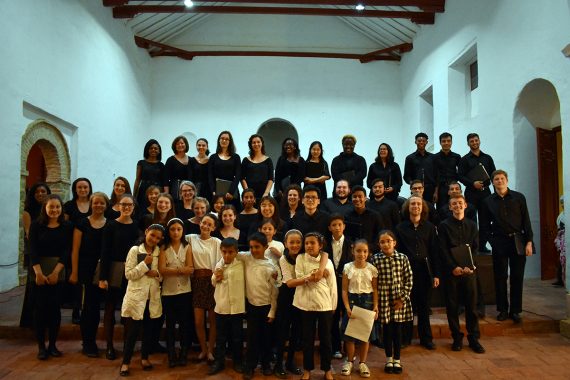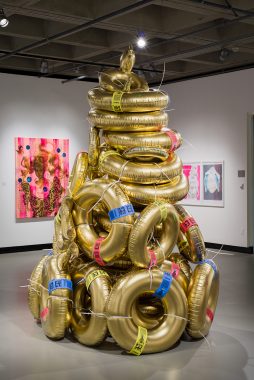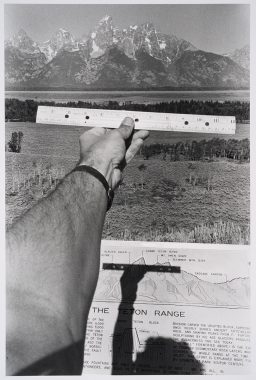Acting and reacting
“Think of someone who gave you a great pep talk. Who was that person?” Actress Liz Hayden, dressed as an athletic coach, posed this question to the audience in Brehmer Theater during the interactive play Pep Talk on September 26. She probed the audience for answers, which included “my mom,” “my soccer coach,” and “my grandfather.”
One audience member, when asked to say more about her grandfather, was overcome with emotion. Her reaction is something for which Portland, Ore.-based theater company Hand2Mouth tries to prepare.
“When we make a show that’s interactive, we spend a lot of time testing it,” explained Jonathan Walters, Hand2Mouth founder and artistic director. “We bring people in from the community, from all different walks of life, to learn how the audience will react and how we should react to them.”
As part of Hand2Mouth’s weeklong residency at Colgate, Walters visited professor Christian DuComb’s American Theater class to discuss Pep Talk the day after the performance.
“This is a show that involves risk, for both the audience and the performers,” DuComb said, “but the audience might not know that they’re taking a risk when they enter the theater. You can never predict how every audience member is going to react.”
Later in the week, Hand2Mouth showed a different side. Berlin Diary followed a playwright as she grappled with the meaning of family after discovering a diary her great-grandfather wrote during the Holocaust. After the play, German professor Matthew Miller facilitated a discussion about home, heritage, and the Jewish diaspora.
“The second play wasn’t interactive, but it was still deeply personal,” Erin Moroney ’18 said. “It’s interesting to see how different styles of theater can cause different reactions in the audience.”
Coming to America
A tower of golden inner tubes strapped with JFK luggage tags, Cathedral/Catedral was the centerpiece of Scherezade Garcia’s exhibition It’s So Sunny That It’s Dark, which ran September 6–October 8 in Clifford Gallery.
In her work, Garcia — who emigrated from the Dominican Republic to New York City in 1986 when she received a full scholarship to the Parsons School of Design — addresses themes of displacement and adaptation. Coming from one island to another, she said, she’s always been surrounded by water. Throughout history, people have traveled this “liquid highway,” Garcia said, and “our DNA is in those waters in between the continents.”
Identity and cultural heritage are prominent motifs in the artist’s mixed-media pieces. In Talking the Talk, Walking the Walk II, the Statue of Liberty is portrayed as a woman of color. “I call her cinnamon,” Garcia said. “Because it’s inclusive. The moment you mix paints, you are being completely inclusive because you are rejecting the idea of pure.”
Deconstructing icons such as the Statue of Liberty and Mickey Mouse, Garcia aims to provoke and inspire discussion, but not state her intention. “You can build your own narrative,” she said. “It’s the meaning you give it.”
Garcia’s use of rich colors — especially gold — and playful strokes give drama to her work. “The situation we are living right now, the state of las Américas, there is so much gold and glitter — [it’s like,] ‘let me entertain you so you don’t see how tragic this is,’” she said.
As evidenced by the exhibition’s title, It’s So Sunny That It’s Dark embraces extremes and “beautiful contradictions,” Garcia explained. With what she calls a “pride of place,” Garcia acknowledges the beauty of our continent while also alluding to our painful history.
In addition to her exhibition, Garcia hosted a workshop in the Coop called “How Do You Color Freedom?” in which participants discussed and then created art around the concepts of freedom. Get a glimpse: colgate.edu/garciavideo
Environmental conditions then and now

These Inuit tools from the early 20th century represent just one community featured in the exhibition Unsettled Conditions: How We Talk about the Environment and Our Place in It. Photo by Mark R. Williams
In the late 20th century, the people of Papua New Guinea faced a challenge.
Communities were trying to resist development in their ancestral forest areas, so they had to come up with an alternative economic model. They settled on making tapa, a pounded barkcloth, for market — the same material displayed in a current exhibition in the Longyear Museum of Anthropology.
Unsettled Conditions: How We Talk about the Environment and Our Place in It runs until December 17. The exhibition focuses not just on the environmental problems we faced in the past and the ones we face today, but also how we break down and talk about those issues.
“We’re looking at how communities in different parts of the world that are connected to the objects we have in the collection are grappling with environmental issues, especially those that are changing their livelihoods and are impacting the way their communities can survive into the future,” said Christy DeLair, associate curator in the Longyear.
With the idea of having the Colgate and Hamilton communities participate in the exhibition, DeLair and several students spent a few weekends at the Hamilton Farmers’ Market asking people to submit videos talking about their interactions with the environment. If people had objects representing those interactions, those were accepted, too.
Also, a video booth in the museum allows visitors to add their voices to the exhibition, and polling stations are situated around the room asking the public for their opinions about different aspects of the show. Students visiting the exhibition for class can answer questions about the experience on iPads throughout the museum, and their responses will be put on display.
“We’re trying to get as many people’s voices into the museum as possible,” DeLair said.
In addition to helping conceptualize the exhibition, students also did the research for each section of Unsettled Conditions and selected the pieces that would go into them. They chose to focus on four key groups of people around the globe: the Tuareg people of the Sahara Desert, the Inuit in the Arctic, communities in Southeast Asia and Oceania, and central New York. The exhibition includes pieces such as an Inuit doll, a war charm, a baby carrier, tent posts, and vintage photographs of central New York. These photos show changes to the Colgate campus community, but also show Hamilton and how human interactions have affected the local landscape.
Sierra Sunshine ’18, an anthropology and Native American studies major and curatorial assistant, gained experience that she hopes will help her as she considers a career in environmental science. “I love working in the museum setting in general,” she said, “but this exhibition is very topical.”
Colgate Choir in Colombia

The University Chorus with the Children’s Choir of Villa de Leyva, Colombia. Photo by Pilar Mejia Barrera
After studying and performing Music of the Americas in Hamilton last spring, 42 members of the University Chorus and Chamber Singers took their performance to Colombia. Named for the music of North and South America, the Music of the Americas performance celebrated the cultures and shared musical history of the continents. In addition to performing music, students explored a number of Colombian cities and engaged with local communities.
The tour focused on the art and folk music of Latin America and the United States; the chorus sang in Latin, Spanish, and English. “We were delighted to also learn some uniquely Colombian music for joint performances at a few venues,” said Ryan Endris, assistant professor of music and director of choral and vocal activities.
In many cities, Colgate students engaged in musical and cultural exchange with local university students. “Some of my favorite moments from the trip were the exchanges with other choirs,” Ben Fetzner ’17 said. “It was really special because we were able to share the language of music with people whom we could not necessarily communicate with otherwise.”
The choir performed in churches and auditoriums, but they also had a few impromptu concerts — singing on the top of the Rock of Guatapé and performing for their tour guides on some of their many bus tours around the country.
Although the group had a busy performance schedule, they visited a number of cultural sites, including the Gold Museum in Bogotá, the Salt Cathedral in Zipaquirá, and the walled city and the Castle of San Felipe in Cartagena. The group also experienced the natural life of Colombia, canoeing through mangroves and spending time on local beaches.
On November 12 at 3:30 p.m., the University Chorus and Chamber singers will perform Music of the Americas II in the chapel, bringing their concert tour of Colombia full circle.
— Melanie Oliva ’18
Ever wonder how artists interact with the landscapes they portray?
Picker Art Gallery’s latest exhibition, Landmarked: Selected Landscapes from the Permanent Collection, features artwork that examines artists’ relationships with the environment. Through paintings, drawings, and photographs, Landmarked takes a look at how artists recreate landscapes and how those same landscapes influence the philosophical, social, political, and economic aspects of the artists themselves. Featuring artists from the 17th to the 21st century, such as Jean-Baptiste-Camille Corot and Catherine Opie, the exhibition runs through December.








